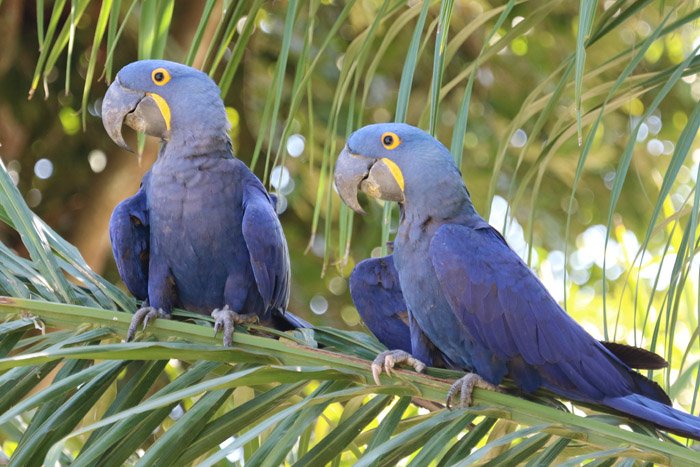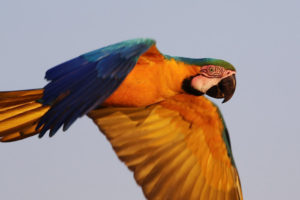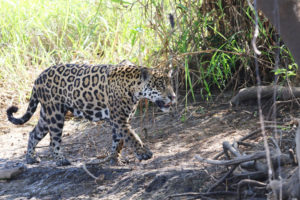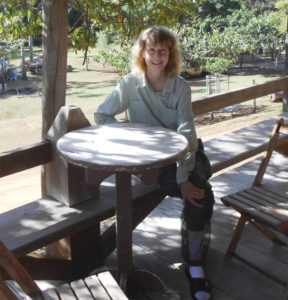By Joyce Miller, Chronicle Freelance
Editor’s note: Joyce Miller, Distinguished Professor of Library Science at SUNY Adirondack, was a founding staff member of The Chronicle in 1980 and was our first Arts Editor, among many responsibilities here over many years. She’s an ardent bird-watcher. Earlier this summer she went to Brazil.
Imagine the sound of European emergency sirens — you know, “EEEE-OOOOO! EEEE-OOOOO!” Then envision it performed by a phalanx of extremely hoarse, screechy bugles and crank the decibels way, way up. That’s the cacophonous pre-dawn call of a flock of Chaco Chachalacas, long-tailed chicken-like birds in Brazil.
The sound made our eyes pop open very quickly at 5:30 a.m.
I visited western Brazil during the first two weeks of July with seven other birders on a trip with the birding tour company Field Guides, Inc. We were close to the Bolivian border, smack dab in the center of South America, 4,200 miles directly south of Glens Falls. We split our time between two areas of Mato Grosso state: the Amazon River basin and the Pantanal wetlands. We were there to see birds and other wildlife, includng jaguars.
Flying from Newark to Sao Paolo to Cuiabá (coo-ya-BA) in central Brazil, we then drove 180 miles north to the charming, family-run Garden of the Amazon lodge. It’s located on the Rio Claro, which drains eventually into the Amazon River.

Out by 6:30 a.m., we’d bird for about 15 hours a day, taking breaks for lunch and dinner. We’d troll along placid rivers in small aluminum boats or walk on leathery-leaf-carpeted forest trails. In the evening, we’d hike through the woods with flashlights or take a jeep jaunt through fields looking for owls, nightjars, potoos and other night-flying birds.
Saw 234 bird species for first time
Why bird in Brazil? It’s one of the most bird-diverse areas of the world. I tallied 337 species over the two weeks. Of those, 234 were “lifers,” species I observed for the first time. I’ve now seen more than 2,500 of the 10,000 species in the world.
What birder could resist seeing birds with wonderfully descriptive names like Screaming Piha, Southern Screamer, Toco Toucan, Great Potoo, Spangled Continga, Glittering-throated Emerald (a hummingbird), Snethlage’s Tody-tyrant and Sibilant Sirystes? We also saw the rare Cone-billed Tanager, rediscovered recently by a team of birders including our guide, Marcelo Padua.
We regularly saw capybara, the world’s largest rodent, looking like dog-sized guinea pigs. They grazed after dark on the grass around the lodges. Marcelo called them the local lawnmowers.
Every day on the shores and in rivers, we’d see dozens of caiman, medium-sized alligator cousins that can reach six to eight feet in length. They sunned themselves on riverbanks or floated quietly in the rivers, slowly sinking into the murky river as our boat approached. They require less than a pound of fish a day, so they spend most of their time getting warm.

After five days in the Amazon basin, we drove 150 miles south of Cuiabá to the Pantanal wetlands. The only road into the region is the Trans-Pantanal Highway, a very dusty washboard dirt road almost 100 miles long, patched together by more than 120 ramshackle wooden bridges. The road finally dead-ends in Porto Jofre at the Cuiabá River.
World’s largest tropical wetland
The Pantanal, about 10 times bigger than the Everglades, is the world’s largest tropical wetlands, sprawling into Bolivia and Paraguay. The area is flooded for three months of the year, with up to 90% of the wetland under several feet of water. July is the dry season, when water — and birds — are concentrated in smaller areas. The region is also popular with anglers.
I was surprised to see that the Pantanal was made of forest, savanna and marsh, not lush rainforest. It actually looked somewhat like upstate New York woods, but completely flat and with more palm trees. Our guide explained that large rainforest trees and thick tropical vines don’t thrive in a floodplain.
In the Pantanal, Hyacinth Macaws are the big birding attraction. They are the world’s largest parrot, 39 inches long. They are now rare in the wild, the population decimated by the caged-bird trade and habitat destruction. These midnight-blue birds screeched and preened in a large tree in the center of the Porto Jofre lodge property. We spent our free time watching them as they ripped small branches off the tree, investigated ant nests and chased each other.
Another striking Pantanal bird is the Jabiru stork, almost five feet tall with a very long, sloped black bill, bulbous red and black neck, and white feathers.
Jaguar-watching, too
This trip was also billed as a jaguar-watching trip. Jaguars are the third largest “big cat” in the world, after tigers and lions. Stockier than leopards, they are typically tawny tan with pattern of black rosettes. These endangered cats usually weigh from 100 to 250 pounds; females are smaller than males.

Their bite is powerful enough to crush a turtle shell. Originally found as far north as the Grand Canyon, they’re now found in Central and South America. Caiman and capybaras are their frequent prey.
From boats on the Pantanal’s Cuiabá River, we saw five jaguars. One day, we watched a pair of adolescent siblings that were hunting together for their first year on their own, and a large female who occasionally tried to pounce on caiman as she strolled along the riverbank. When she walked in tall riverside grass, shrieking birds shot out of the grass and caiman slid into the water. Another day, we saw a mother trailed by a cub.
We were warned not to walk around the lodge property at night: security cameras have photographed jaguars walking around the grounds. For “restroom” stops during the six-hour boat rides, our guide would jump ashore first to inspect the area for signs of jaguars and as well as Africanized bee swarms. On our morning walks on the forest trails, we noticed signs of nocturnal animals in the soft dirt: tracks left by tapirs, giant anteaters, centipedes — and jaguars. I measured one jaguar print to be about 4½ inches in diameter.
Swarms of brilliant butterflies
We saw other wildlife, too. In the Amazon basin, we were thrilled to find swarms of brilliant orange, yellow, blue, green, and zebra-striped butterflies sipping up minerals from mud puddles. We saw Giant Otters, Black Howler Monkeys and several petite, curious Black-tailed Marmosets, monkeys which chirped like chickadees. Leafcutter Ants raced along forest trails in their own tiny two-lane highways.
An Elephant Beetle the size of a man’s hand greeted us on the lodge sidewalk one evening. Though we didn’t see anacondas and piranhas, we were assured that they were swimming under our boats.
Piranha are the vultures of the river, our guide Marcelo said; they eat dead things in the water. They don’t attack and devour live people, no matter what James Bond movies have depicted.
On one twilight boat ride in the Pantanal, we were treated to an air show by Greater and Lesser Bulldog Bats, also known as fishing bats. Dozens swirled high over our heads, snapping up insects. As it got darker, they swooped down around our boat, using echolocation and their hind claws to snag small fish from the surface.
Mosquitoes no problem in dry season
Because it was the dry winter season, mosquitoes were not a big problem. More bothersome were seed ticks, the size of a poppy seed, but they don’t carry disease. We sprayed clothes before the trip with permethrin, dusted ourselves with sublimed sulfur powder, and spritzed unscented picaridin insect repellent on ourselves to deter them.
The Pantanal road is tough on vehicles. Our dust-choked bus engine finally died 10 miles before we reached the end of the road in the Pantanal. There’s certainly no cell phone service in this remote area, so Marcelo asked another group of birders heading the other way to stop at the next lodge and call the Hotel Porto Jofre to send help.

After a two-hour wait in the dark, a diesel truck chugged up the road with three burly lodge workers. We hauled ourselves into the wood-slatted truck bed, they tossed the luggage in, and we trundled the last few miles to the lodge. Our driver and a mechanic fixed the bus the next morning.
Just a fraction of the region is protected from development. Much of the forest in the Pantanal is now gone as large-scale commercial agriculture moves in. We saw hundreds of Brahman cattle and endless fields of cotton, soybeans, corn and sugar cane.
Fortunately, the Southern Cross constellation and Milky Way were still brilliant in the Southern Hemisphere night sky: no light pollution there yet.
As Brazil gears up for the Olympics with its glitz and security concerns, I’ll be thinking of the other Brazil: quiet, beautiful and very wild.
Copyright © 2016 Lone Oak Publishing Co., Inc. All Rights Reserved.
 Glens Falls Chronicle Serving the Glens Falls/Lake George region; Warren, Washington and northern Saratoga counties since 1980
Glens Falls Chronicle Serving the Glens Falls/Lake George region; Warren, Washington and northern Saratoga counties since 1980

